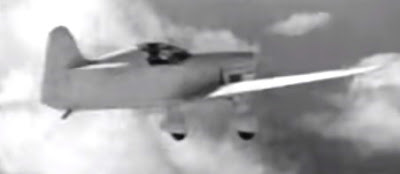Quite early in the film, there is an aerial dogfight between two 'fighters'.
They are in fact a Percival Mew Gull ...
... and a Hawker Fury.
These were both civilian-registered aircraft, and the Fury was retained by Hawker as part of the development programme that eventually led to the Fury Mark II.
Percival Mew Gull
The Mew Gull was a single-seat racing monoplane built by the Percival Aircraft Company between 1934 and 1938. Only five were built and they dominated aircraft racing in the UK in the runup to the outbreak of the Second World War.
The aircraft's characteristics were:
- Dimensions:
- Length: 20ft 3in (6.17m)
- Wingspan: 24ft (7.32m)
- Height: 6ft 10in (2.08m)
- Wing area: 88 sq ft (8.2 m2)
- Weight:
- Empty: 1,150lbs (522kg)
- Gross: 2,125lbs (964kg)
- Powerplant: 1 × de Havilland Gipsy Six 6-cylinder air-cooled 200hp inverted in-line piston engine driving a 2-bladed variable-pitch metal propeller
- Performance
- Maximum speed: 240mph (390km/h, 210 knots)
- Cruising speed: 230mph (370km/h, 200 knots) at 7,000ft (2,100m)
- Range: 1,500 miles (2,400km, 1,300 nautical miles) at at 228mph (367km/h)
Hawker Fury
The Fury was a single-seat biplane fighter built by the Hawker Aircraft Company from 1931 onwards. 275 were built in two marks (Mark I (87) and Mark II (112) and the aircraft was operated by the Royal Airforce (196) as well as the air forces of Norway (1), Iran (22), Portugal (3), South Africa (ex-RAF aircraft), Spain (3), and the Yugoslavia (50).
The Fury Mark II's characteristics were:
- Dimensions:
- Length: 26ft 9in (8.15m)
- Wingspan: 30ft (9.14m)
- Height: 10ft 2in (3.10m)
- Wing area: 252sq ft (23.4m2)
- Weight:
- Empty: 2,734lbs (1,240kg)
- Maximum: 3,609lbs (1,637kg)
- Powerplant: 1 × Rolls-Royce Kestrel IV liquid-cooled 640hp V12 engine
- Performance:
- Maximum speed: 223mph (359km/h, 194 knots) at 16,500ft (5,000m)
- Range: 270 miles (430km, 230 nautical miles)
- Service ceiling: 29,500ft (9,000m)
- Armament: 2 × 0.303inch (7.7mm) Vickers Mk IV machine guns with 600 rounds per gun






















.jpeg)
















That's very interesting Bob - looking at the specifications, the Mew Gull went faster with only 200hp against the Fury's 640hp! ( albeit the Mew Gull is one-third lighter in weight )
ReplyDeleteNo wonder monoplane fighters took over..
And I do hope that was only a model in the 'crash' picture!
David in Suffolk,
ReplyDeleteSurprisingly, unlike many sport/racing aircraft of the period, the Mew Gull did not serve as a basis for a light fighter. Its manufacturer did, however, design a number of trainer aircraft that were used by the RAF (Proctor, which was based on the Vega Gull, the Prentice, and later the Provost ... which was itself developed into the Jet Provost and Strikemaster).
All the best,
Bob